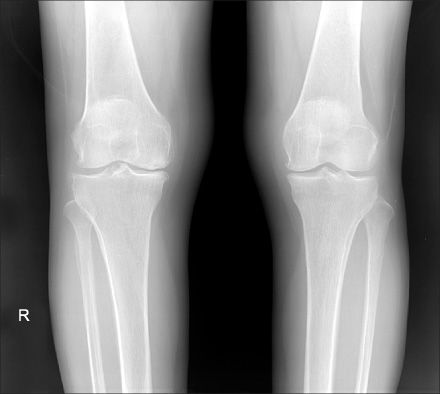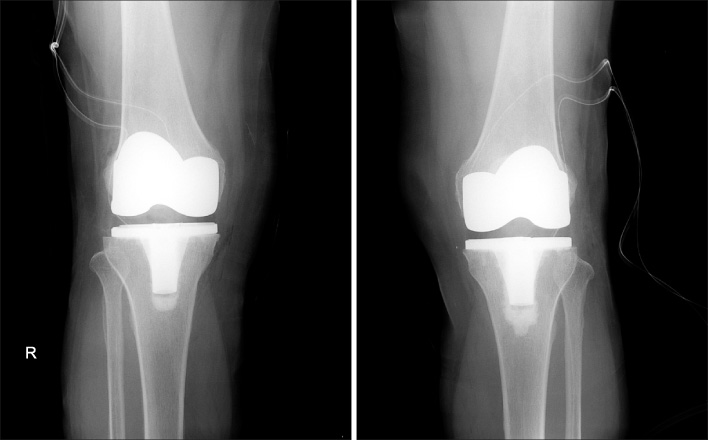J Korean Orthop Assoc.
2008 Feb;43(1):78-85. 10.4055/jkoa.2008.43.1.78.
Early Results of MIS-QS Total Knee Arthroplasty: A Comparison with Conventional Procedure for the Same Patient
- Affiliations
-
- 1Department of Orthopedic Surgery, Gangneung Asan Hospital,Ulsan University College of Medicine, Gangneung, Korea. osteotome@hanmail.net
- KMID: 2106420
- DOI: http://doi.org/10.4055/jkoa.2008.43.1.78
Abstract
-
PURPOSE: This study assessed the early clinical and radiological results of Minimally Invasive Surgery- Quadriceps sparing total knee arthroplasty (MIS-QS TKA), and compared these results with those of conventional TKA.
MATERIALS AND METHODS
Between August 2004 and March 2005, 17 patients with bilateral TKA on their one side using a regular procedure and the other using the MIS-QS technique were evaluated and compared. The clinical assessment was performed by measuring the range of motion, Knee Society Score, and a radiological evaluation by standing anteroposterior, supine lateral, and Merchant view preoperatively, 2 weeks, 6 weeks, 3 months and 1 year after surgery. Statistical analysis was performed using a paired t-test.
RESULTS
The average range of knee motion was slightly larger in the MIS-QS group at all periodsbut there was no statistical difference between the two groups. The Knee Society Score was similar at the 3 month and 1 year periods. The alignment of the implants was satisfactory in both groups and postoperative patellar alignment checked in the Merchant view was better in the MIS-QS group at all periods.
CONCLUSION
There were no differences in the clinical aspects at 1 year period between the two groups. However, the MIS-QS group showed better patellar alignment than the conventional group for up to 1 year.
Figure
Reference
-
1. Alan RK, Tria AJ Jr. Quadriceps-sparing total knee arthroplasty using the posterior stabilized TKA design. J Knee Surg. 2006. 19:71–76.
Article2. Arendt EA, Fithian DC, Cohen E. Current concepts of lateral patellar dislocation. Clin Sports Med. 2002. 21:499–519.3. Bae DK, Yoon KH, Kim SG, Park JW, Park SW. Minimally invasive quadriceps sparing total knee arthroplasty. J Korean Knee Soc. 2005. 17:252–257.4. Berend KR, Lombardi AV Jr. Avoiding the potential pitfalls of minimally invasive total knee surgery. Orthopedics. 2005. 28:1326–1330.
Article5. Bindelglass DF, Vince KG. Patellar tilt and subluxation following subvastus and parapatellar approach in total knee arthroplasty. Implication for surgical technique. J Arthroplasty. 1996. 11:507–511.6. Bonutti PM, Mont MA, McMahon M, Ragland PS, Kester M. Minimally invasive total knee arthroplasty. J Bone Joint Surg Am. 2004. 86:Suppl 2. S26–S32.
Article7. Bozic KJ, Hansen E. The economics of minimally invasive total knee arthroplasty. J Knee Surg. 2006. 19:149–152.
Article8. Chan KC, Gill GS. Postoperative patellar tilt in total knee arthroplasty. J Arthroplasty. 1999. 14:300–304.
Article9. Choi YJ, Tanavalee A, Chan APH, Coon TM, Tria AJ. Scuderi GR, Tria AJ, editors. Minimally invasive surgery for total knee arthroplasty. MIS of the hip and the knee- a clinical perspective. 2004. New York: Springer-Verlag Inc;187–198.
Article10. Cook JL, Cushner FD, Scuderi GS. Minimal-incision total knee arthroplasty. J Knee Surg. 2006. 19:46–51.
Article11. Dalury DF, Dennis DA. Mini-incision total knee arthroplasty can increase risk of component malalignment. Clin Orthop Relat Res. 2005. 440:77–81.
Article12. Goble EM, Justin DF. Minimally invasive total knee arthroplasty: principles and technique. Orthop Clin North Am. 2004. 35:235–245.13. Kawano T, Miura H, Nagamine R, et al. Factors affecting patellar tracking after total knee arthroplasty. J Arthroplasty. 2002. 17:942–947.
Article14. Laskin RS. Minimally invasive total knee arthroplasty: the results justify its use. Clin Orthop Relat Res. 2005. 440:54–59.15. Ozkoc G, Hersekli MA, Akpinar S, et al. Time dependent changes in patellar tracking with medial parapatellar and midvastus approaches. Knee Surg Sports Traumatol Arthrosc. 2005. 13:654–657.
Article16. Repicci JA, Eberle RW. Minimally invasive surgical technique for unicondylar knee arthroplasty. J South Orthop Assoc. 1999. 8:20–27.17. Tenholder M, Clarke HD, Scuderi GR. Minimal-incision total knee arthroplasty: the early clinical experience. Clin Orthop Relat Res. 2005. 440:67–76.18. Tria AJ Jr, Coon TM. Minimal incision total knee arthroplasty: early experience. Clin Orthop Relat Res. 2003. 416:185–190.
Article19. Tria AJ Jr. Minimally invasive total knee arthroplasty: the importance of instrumentation. Orthop Clin North Am. 2004. 35:227–234.
Article20. Tria AJ Jr. Exploring the depths of minimally invasive quadriceps-sparing total knee arthroplasty. Orthopedics. 2006. 29:214–215.
Article21. Yoo JH, Han DY, Han CD, Oh HC, Oh IH. Radiologic evaluation of quadriceps-sparing minimally invasive total knee arthroplasty. J Korean Orthop Assoc. 2006. 41:454–460.
- Full Text Links
- Actions
-
Cited
- CITED
-
- Close
- Share
- Similar articles
-
- Minimally Invasive Quadriceps Sparing Total Knee Arthroplasty
- Minimally Invasive Total Knee Arthroplasty
- Comparison of the Outcome in Bilateral Staged Total Hip Arthroplasty: Modified Two-Incision Minimally Invasive Technique versus the Conventional Posterolateral Approach
- Total Elbow Arthroplasty for the Fracture of Elbow Arthrodesis Site: A Case Report
- Epidural Abscess Following Epidural Catheterization for Painless Mobilization after Total Knee Arthroplasty





